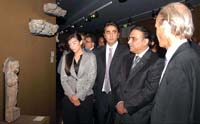04.08.2010
 President Asif Ali Zardari on Monday visited the special Gandhara exhibition here at the National Museum of Asian Art Guimet, that is drawing large crowds and presenting a soft and rich image of Pakistan. Chairman PPP Bilawal Bhutto Zardari and Aseefa Bhutto Zardari also accompanied the President.
President Asif Ali Zardari on Monday visited the special Gandhara exhibition here at the National Museum of Asian Art Guimet, that is drawing large crowds and presenting a soft and rich image of Pakistan. Chairman PPP Bilawal Bhutto Zardari and Aseefa Bhutto Zardari also accompanied the President.
The exhibition – “Pakistan – Where Civilizations meet” has on display the Buddhist Heritage of Pakistan, its legends and monasteries. It focuses on ancient Gandhara civilization- land of Buddhism, that witnessed encounters, invasions and exchanges, with ancient culture and diversities. The event that has attracted over 27000 visitors to date will continue till Aug 16 and has been the centre of interest for French and other art lovers from all over the world.
“It is a very good exhibition and the Parisians have responded very positively,” Helen Lefevre, head of communications of the Musee Guimet told APP. “With so many museums vying to attract the most crowds, we had a very good response and people loved the Gandhara exhibition.”
Prime Minister Syed Yusuf Raza Gilani was scheduled to inaugurate the exhibition in April this year, but the visit was cancelled due to the air travel restrictions in the wake of an Icelandic volcanic eruption.
A series of events have been arranged to promote soft image of Pakistan in France during the year including a festival – “Pakistan in Paris,” and month long series of cultural activities showcasing Pakistani music, dance, cinema and puppetry, in Paris, organized by the Foundation of Alliance France.
A photographic exhibition on the archaeological sites of Moenjodaro was also arranged at UNESCO Headquarters, early this year.
The President visited various sections of the museum that have on display statues of Buddha and revered deities, low reliefs of temples and stupas, that appear alongside terracotta and stucco items from monasteries and palaces. This international exhibition, for the first time in France, presented 200 exceptional Greco-Buddhist works of art, typical of the Gandhara.
Gandhara witnessed the birth and development of a civilization combining Greek influences, resulting from the conquests of Alexander the Great, and Persian and Indian inspirations. The exhibition portrays the Gandhara civilization – a former kingdom with a Hellenistic influence that spanned across many parts of the country. The civilization contemporary with the Romans in the west and the Chinese Hans in the east, peaked between the 1st and 3rd century AD, in the era of the successors of Alexander the Great and the Kushan Empire.
“The exhibition has brought the magnificent centuries old civilization to the people, who are fascinated by its grandeur,” Helen Lefevre said.
The Gandhara art bridges the gap between continents and western and eastern cultures, offering a multiplicity of artistic forms beckoning to discover a world where beauty and humanity prevail. “The exhibition has changed my perceptions about Pakistan,” said Maria Albert a British national. “It is fascinating to know the rich historical past that your country inherits and now I will definitely visit to see for myself your beautiful country.”
The Paris exhibition has been commissioned by Pierre Cambon, head curator of the Guimet museum. The museum was the brain-child of Emile Guimet (1836-1918), a Lyons industrialist who devised the grand project of opening a museum devoted to the religions of Ancient Egypt, Classical Antiquity, and Asia.
The exhibition has travelled so far to Germany and Switzerland. After a presentation in Bonn in 2008/2009 and Berlin in 2009, the exhibition completed its journey in early January in Zurich. The Paris stage focuses on the chronology of the influences.
The travelling exhibition has been held in cooperation with the government of Pakistan, Department of Archaeology and Museums, Islamabad Museum, Taxila Museum, National Museum of Pakistan, Karachi, Swat Museum, Saidu Sharif, Lahore Museum, Peshawar Museum, Dir Museum, Chakdara, the SSAQ Museum of archaeology and ethnology of the university of Peshawar. The President also signed the visitors book.
Source: Associated Press of Pakistan




